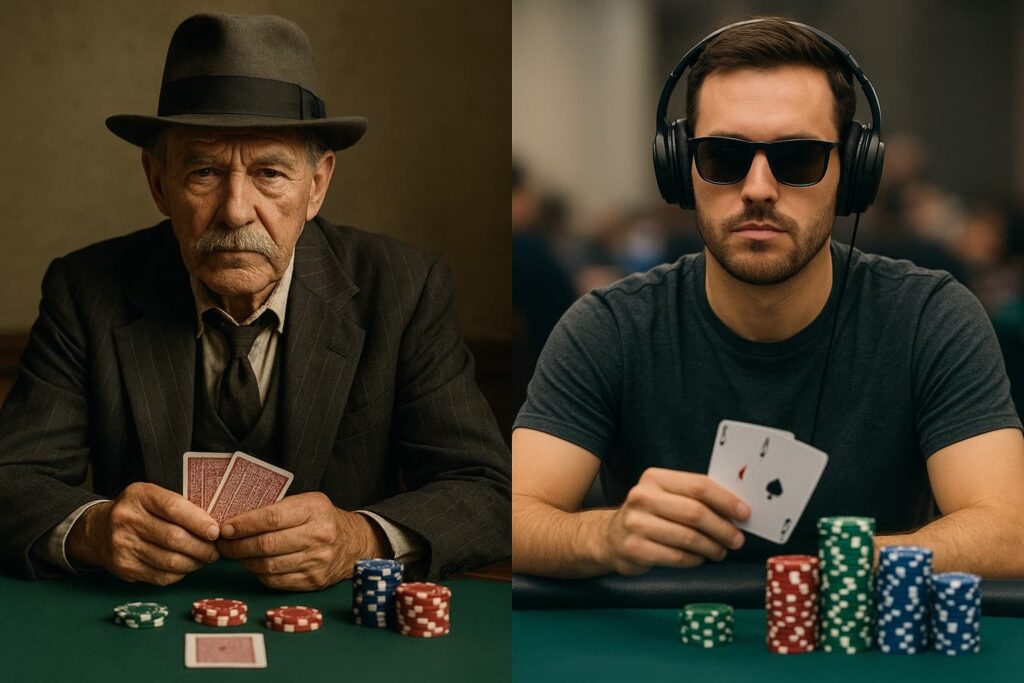The poker world is constantly evolving, sparking a fascinating debate: Who would win in a heads-up match between a poker legend from the “old school” and a modern-day pro raised in the era of data?. This question delves into a strategic clash between two distinct philosophies: the intuition-heavy “exploitative era” of the past and the data-driven “solver era” of today.
While it’s tempting to pick a side, the truth is that the ideal poker player in the current landscape is a
hybrid, blending the sharpest skills from both worlds. Let’s break down each approach to see why.

A Look Back: The Old School “Exploitative Era”
The exploitative era, dating back a decade or more, was defined by a straightforward goal: win the most money possible by adopting an exploitative style. Game Theory Optimal (GTO) play was not yet understood or widely accessible, so players relied on a different set of skills to get an edge.
Key Skills and Characteristics:
- Player Profiling: Without solver outputs, players leaned heavily on player profiling and meticulous note-taking to understand their opponents’ tendencies.
- HUDs were King: Heads-Up Displays (HUDs) were critical for spotting exploitable patterns and separating the pros from recreational players.
- Strong Intuition: In a time before provable solutions, players had to trust their gut. The most successful players were those whose intuition was right more often than it was wrong.
- Early Range Analysis: Some training involved “combo counting” to estimate an opponent’s range, which helped players develop the crucial skill of thinking in ranges.
The “Dark Side” of Old School Play:
- Flawed Strategies: Even top professional players held some confused ideas about optimal strategy.
- Extremely Tight Ranges: Players often had what would now be considered “insane” pre-flop ranges, such as folding King-Jack offsuit from the big blind.
- Limited Concepts: Most players were “shackled” by the idea that every bet had to be either for value or as a bluff, without grasping concepts like equity denial.
- Misunderstood GTO: When GTO was discussed, its application was often incorrect, focusing on simple range-versus-range equity rather than the more important factor of equity distribution.
- Lack of Data: Without access to population data, players had to rely on speculative assumptions about how often their opponents might fold.
The Modern Game: Enter the “Solver Era”
Today’s game is marked by a general “obsession with GTO,” with players analyzing solver outputs and pre-solved solutions to build their strategies.
Key Skills and Characteristics:
- GTO Focus: For many new players, every decision is related to GTO. Plays are often based on “what the solver is doing in this scenario”.
- Access to Solvers: Tools like PioSolver or GTO+ are now standard, allowing players to run their own simulations or study pre-solved spots.
- Superior Pre-flop Play: A modern player’s pre-flop strategy is likely far better than that of a professional who relied purely on intuition 10-15 years ago.
- Population Data: Modern players can access large pools of data, giving them more accurate insights into typical opponent tendencies.
Potential Risks of the Modern Approach:
- Loss of Core Skills: A sole focus on solver output means new players may never develop fundamental skills like player profiling, note-taking, or a strong intuition.
- Ignoring Opponents: GTO study often assumes you’re playing against a perfect GTO opponent, which leads to ignoring crucial player profiling.
- Incomplete Development: Some modern training stables may just teach players to “click buttons” based on solver outputs, failing to develop their ability to think like a complete poker player.
- A Drop in Caliber?: There is a concern that this might be the first era where the average caliber of a new player has decreased, as they may jump into games without understanding exploitative play or using a HUD.
The Verdict: The Hybrid Player Reigns Supreme
So, who wins? Ultimately,
neither a purely old-school nor a purely modern player comes out on top in today’s complex game. The “ideal poker player” is one who successfully combines the strengths of both eras.
Characteristics of the Ideal Hybrid Player:
- Fundamentally Exploitative: Their core mission is to generate the maximum exploit strategy against their opponents.
- Uses Solvers as a Tool: They work with solvers to deepen their understanding of theory and exploitative play, not as a crutch to avoid it.
- Master of Profiling: They have a strong understanding of HUD stats and can adapt their strategy based on opponent types like nits, tags, and lags.
- Data-Driven: They understand pool data and can perform basic Expected Value (EV) calculations to find the most profitable lines.
- Developed Intuition: They possess an intuitive feel for the game, which helps them navigate close spots where theory isn’t perfectly clear.
By checking all of these boxes, a player is “well on their way to becoming the ideal player”. The true winner in the modern poker world is the well-rounded individual who skillfully integrates powerful analytical tools with timeless, intuitive, and exploitative skills.
